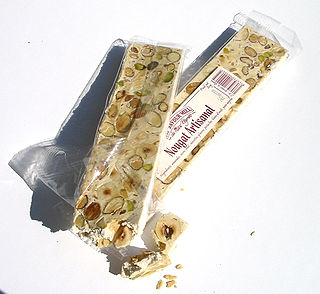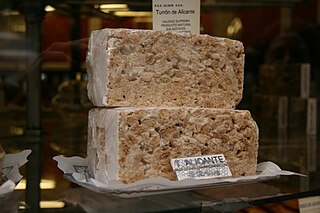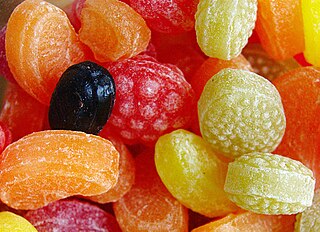
Confectionery is the art of making confections, which are food items that are rich in sugar and carbohydrates. Exact definitions are difficult. In general, however, confectionery is divided into two broad and somewhat overlapping categories: bakers' confections and sugar confections. The occupation of confectioner encompasses the categories of cooking performed by both the French patissier and the confiseur.

Halva is a type of confectionery originating from Iran and widely spread throughout the Middle East and India. The name is used for a broad variety of recipes, generally a thick paste made from flour, butter, liquid oil, saffron, rosewater, milk, cocoa powder, and sweetened with sugar.

A croquembouche or croque-en-bouche is a French dessert consisting of choux pastry puffs piled into a cone and bound with threads of caramel. In Italy and France, it is often served at weddings, baptisms and first communions.

Nougat is a family of confections made with sugar or honey, roasted nuts, whipped egg whites, and sometimes chopped candied fruit. The consistency of nougat is chewy, and it is used in a variety of candy bars and chocolates. The word nougat comes from Occitan pan nogat, seemingly from Latin panis nucatus 'nut bread'.

Turrón, or torrone, is a southwestern European nougat confection, typically made of honey, sugar, and egg white, with toasted almonds or other nuts, and usually shaped into either a rectangular tablet or a round cake. It is frequently consumed as a traditional Christmas dessert in Spain, Portugal, and Italy as well as countries formerly under the Spanish Empire and Portuguese Empire, particularly in Latin America.

Marzipan is a confection consisting primarily of sugar, honey, and almond meal, sometimes augmented with almond oil or extract.

The Heath bar is a candy bar made of toffee, almonds, and milk chocolate, first manufactured by the Heath Brothers Confectionery in 1928. Since its acquisition of the Leaf International North American confectionery operations late in 1996, the Heath bar has been manufactured and distributed by Hershey.

An alfajor or alajú is a traditional confection typically made of flour, honey, and nuts. It is found in Argentina, Paraguay, the Philippines, Southern Brazil, Southern France, Spain, Uruguay, Peru, Ecuador, Colombia and Chile. The archetypal alfajor entered Iberia during the period of al-Andalus. It is produced in the form of a small cylinder and is sold either individually or in boxes containing several pieces.

Confetti are small pieces or streamers of paper, mylar, or metallic material which are usually thrown at celebrations, especially parades and weddings. The origins are from the Latin confectum, with confetti the plural of Italian confetto, small sweet. Modern paper confetti trace back to symbolic rituals of tossing grains and sweets during special occasions, traditional for numerous cultures throughout history as an ancient custom dating back to pagan times, but adapted from sweets and grains to paper through the centuries. Confetti are manufactured in multiple colors, and commercially available confetti come in many different shapes. A distinction is made between confetti and glitter; glitter is smaller than confetti and is universally shiny. Most table confetti are also shiny. While they are called metallic confetti they are actually metallized PVC. The most popular shape is the star. Seasonally, Snowflake Confetti are the most requested shape. Most party supply stores carry paper and metallic confetti. Confetti are commonly used at social gatherings such as parties, weddings, and Bar Mitzvahs. The simplest confetti are simply shredded paper, and can be made with scissors or a paper shredder. Chads punched out of scrap paper are also common. A hole punch makes small round chads, and a ticket punch makes more elaborate chads. Most pieces of paper flats will flutter as tumblewings giving long flight times.

Sugar candy is any candy whose primary ingredient is sugar. The main types of sugar candies are hard candies, fondants, caramels, jellies, and nougats. In British English, this broad category of sugar candies is called sweets, and the name candy or sugar-candy is used only for hard candies that are nearly solid sugar.

Nonpareils are a decorative confectionery of tiny balls made with sugar and starch, traditionally an opaque white but now available in many colors. They are also known as hundreds and thousands in Australia, New Zealand, South Africa and the United Kingdom.

A dragée, also known as a confetto or malbas, is a bite-sized confectionery with a hard outer shell.

A sugar plum originated as a piece of dragée or hard candy made of hardened sugar in a small round or oval shape.

Barley sugar is a traditional variety of boiled sweet, often yellow or orange in colour, which is usually made with an extract of barley, giving it a characteristic taste and colour. It is usually sold in the shape of twisted sticks. Barley sugar is very similar to clear toy candy and to hard caramel candy in its texture and taste.

Jumbles are simple butter cookies made with a basic recipe of flour, sugar, eggs, and butter. They can be flavored with vanilla, anise, or caraway seed used for flavoring, or other flavoring can be used like almond. They were formerly often made in the form of rings or rolls.

Cocada are a traditional coconut confectionery found in many parts of Latin America. They are particularly popular in Argentina, Bolivia, Brazil, Colombia, Chile, the Dominican Republic, Mexico, Panama, Venezuela and Ecuador. They are oven baked but are served at room temperature to provide their chewy and soft texture. Made with eggs and shredded coconut, cocadas come in a variety of colors due to the modern use of food coloring, however the traditional variations are golden brown. They are often garnished with almonds, either whole or chopped. There are hundreds of cocadas recipes, from the typical hard, very sweet balls to cocadas that are almost the creamy texture of flan. Other fruit, often dried, can be added to the cocadas to create variety, which will also lend to a wide spectrum of cocada colors. Cocadas are mentioned as early as 1878 in Peru.

A hard candy, or boiled sweet, is a sugar candy prepared from one or more sugar-based syrups that is heated to a temperature of 160 °C (320 °F) to make candy. Among the many hard candy varieties are stick candy such as the candy cane, lollipops, rock, aniseed twists, and bêtises de Cambrai. "Boiled" is a misnomer, as sucrose melts fully at approximately 186 °C. Further heating breaks it into glucose and fructose molecules before it can vaporize.

Confections of the English Renaissance span a wide range of products. All were heavily based on sugar, which was a relatively new development. Many were considered to have medicinal properties – a belief that was influenced by the Arabic use of sugar as a medicine and that carried over from medieval sugar usage. In the mid-sixteenth century, sugar became cheaper and more widely available to the general populace due to European colonization of the New World. It began to be used more as a flavouring, preservative, and sweetener, as it is today, rather than as medicine.




















